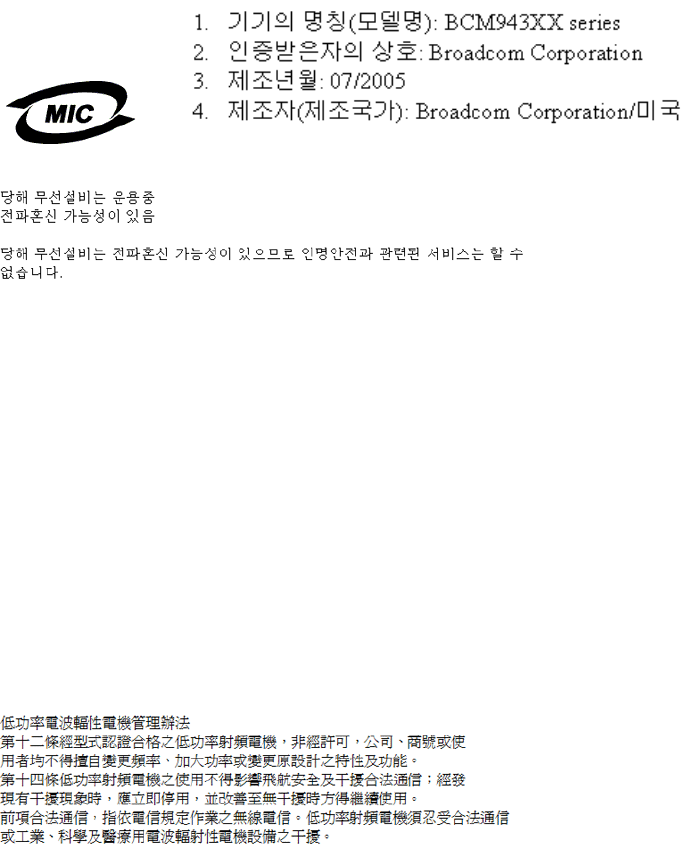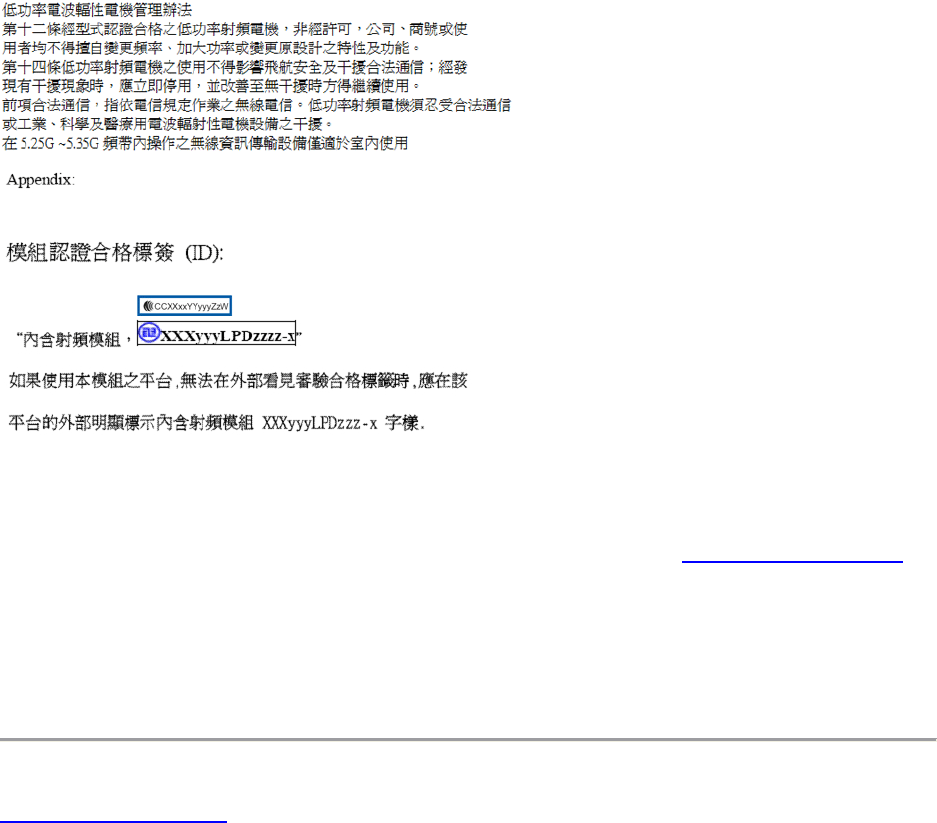Broadcom BRCM1030 Broadcom 802.11g WLAN PCI-E Mini Card User Manual Broadcom Reg UWB BTx
Broadcom Corporation Broadcom 802.11g WLAN PCI-E Mini Card Broadcom Reg UWB BTx
Broadcom >
Contents
- 1. Users Manual
- 2. User Manual
- 3. Manual Statement
- 4. User manual 1 of 2
- 5. User manual 2 of 2
- 6. System User manual
- 7. Manual statement
- 8. User Manual Statement
- 9. Regulatory User Guide
- 10. Bear Manual
- 11. BixbyUG Manual
- 12. Welchs Manual
- 13. User Manual I71C
- 14. User Manual legal part
- 15. User Manual Q44C
- 16. OEM ODM Instruction
- 17. Manual 1
- 18. Manual 2
- 19. Manual 3
- 20. OEM installation guide
- 21. Host user manual
User manual 2 of 2

Back to Contents Page
Regulatory: Dell(TM) Wireless WLAN Card User Guide
Operational Information
Regulatory information
Operational Information
NOTE:
•
EIRP = effective isotropic radiated power (including antenna gain)
•
Your Dell wireless WLAN card transmits less than 100 mW of power, but more than 10 mW.
Wireless Interoperability
Dell wireless WLAN card products are designed to be interoperable with any wireless LAN product that
is based on direct sequence spread spectrum (DSSS) radio technology and orthogonal frequency
division multiplexing (OFDM) and to comply with the following standards:
•
IEEE 802.11a Standard on 5-GHz Wireless LAN
•
IEEE 802.11b-1999 Standard on 2.4-GHz Wireless LAN
•
IEEE 802.11g Standard on 2.4-GHz Wireless LAN
•
IEEE 802.11n Draft Standard on 2.4-GHz and 5-GHz Wireless LAN
•
Wireless Fidelity (Wi-Fi®) certification, as defined by the Wi-Fi Alliance
Safety
Dell wireless WLAN cards, like other radio devices, emit radio frequency electromagnetic energy. The
level of energy emitted by these devices, however, is less than the electromagnetic energy emitted by
other wireless devices such as mobile phones. Dell wireless WLAN card devices operate within the
guidelines found in radio frequency safety standards and recommendations. These standards and
recommendations reflect the consensus of the scientific community and result from deliberations of
panels and committees of scientists who continually review and interpret the extensive research
literature. In some situations or environments, the use of these devices may be restricted by the
proprietor of the building or responsible representatives of the applicable organization. Examples of
such situations include the following:
•
Using the Dell wireless WLAN card equipment on board airplanes, or
•
Using the Dell wireless WLAN card equipment in any other environment where the risk of interference
with other devices or services is perceived or identified as being harmful.
If you are uncertain of the policy that applies to the use of wireless devices in a specific organization
or environment (an airport, for example), you are encouraged to ask for authorization to use the Dell
wireless WLAN card device before you turn it on.
Regulatory information
Dell wireless WLAN card devices must be installed and used in strict accordance with the
manufacturer's instructions as described in the user documentation that comes with the product. For
country-specific approvals, see Radio Approvals. Dell Inc. is not responsible for any radio or television
interference caused by unauthorized modification of the devices included with a Dell wireless WLAN
card kit, or the substitution or attachment of connecting cables and equipment other than that
specified by Dell Inc. The correction of interference caused by such unauthorized modification,
substitution or attachment is the responsibility of the user. Dell Inc. and its authorized resellers or
distributors are not liable for any damage or violation of government regulations that may arise from
the user failing to comply with these guidelines.
USA Federal Communications Commission (FCC)

FCC radiation exposure statement
CAUTION
•
The radiated output power of Dell wireless WLAN card devices is far below the FCC radio
frequency exposure limits. Nevertheless, the device should be used in such a manner that
the potential for human contact during normal operation is minimized. To avoid the
possibility of exceeding the FCC radio frequency exposure limits, you should keep a
distance of at least 20 cm between you (or any other person in the vicinity) and the
antenna that is built into the device.To determine the location of the antenna within your
portable computer, check the information posted on the general Dell support site at
http://support.dell.com/.
•
These devices have also been evaluated and shown to comply with the FCC RF exposure
limits under portable exposure conditions (antennas are within 20 cm of a person's body)
when installed in certain specific OEM configurations. Details of the authorized
configurations can be found at http://www.fcc.gov/oet/ea by entering the FCC ID number
on the device.
Radio Frequency Interference Requirements
NOTICE: Dell Wireless 1450, Dell Wireless 1470, Dell Wireless 1490, and Dell Wireless
1500/1505/1510 products.
•
These devices are restricted to indoor use because they operate in the 5.15 to 5.25-GHz frequency
range. The FCC requires such products to be used indoors for the frequency range 5.15 GHz to 5.25-
GHz to reduce the potential for harmful interference to co-channel Mobile Satellite systems.
•
High-power radars are allocated as primary users of the 5.25 to 5.35-GHz and 5.65 to 5.85-GHz
bands. These radar stations can cause interference with or damage to these devices, or both.
Interference Statement
These devices comply with Part 15 of the FCC Rules. Operation of the devices is subject to the
following two conditions: (1) The devices may not cause harmful interference, and (2) The devices
must accept any interference that may cause undesired operation.
This equipment has been tested and found to comply with the limits for a Class B digital device,
pursuant to Part 15 of the FCC Rules. These limits are designed to provide reasonable protection
against harmful interference in a residential installation. This equipment generates, uses, and can
radiate radio frequency energy. If the equipment is not installed and used in accordance with the
instructions, the equipment may cause harmful interference to radio communications. There is no
guarantee, however, that such interference will not occur in a particular installation. If this equipment
does cause harmful interference to radio or television reception (which can be determined by turning
the equipment off and on), the user is encouraged to try to correct the interference by taking one or
more of the following measures:
•
Relocate this device.
•
Increase the separation between the device and the receiver.
•
Connect the device into an outlet on a circuit different from that of other electronics.
•
Consult the dealer or an experienced radio technician for help.
NOTE: Dell wireless WLAN cards must be installed and used in strict accordance with the
manufacturer's instructions as described in the user documentation that comes with the product. Any
other installation or use will violate FCC Part 15 regulations. Modifications not expressly approved by
Dell could void your authority to operate the equipment.
The radio(s) inside the laptop platform in this user guide are approved to be co-located. No other
radio(s) can be co-located in this laptop platform without FCC approval.
Brazil
Este equipamento opera em caráter secundário, isto é, não tem direito a proteção contra interferência
prejudicial, mesmo de estaçôes do mesmo tipo, e não pode causar interferência a sistemas operando
em caráter primário.
Canada. Industry Canada (IC)
This device complies with RSS210 of Industry Canada.

Operation is subject to the following two conditions: (1) this device may not cause interference, and
(2) this device must accept any interference, including interference that may cause undesired
operation of this device.
L'utilisation de ce dispositif est autorisée seulement aux conditions suivantes: (1) il ne doit pas
produire de brouillage et (2) l'utilisateur du dispositif doit étre prêt à accepter tout brouillage
radioélectrique reçu, même si ce brouillage est susceptible de compromettre le fonctionnement du
dispositif.
The term "IC" before the equipment certification number only signifies that the Industry Canada
technical specifications were met.
To reduce the potential radio interference to other users, the antenna type and gain should be chosen
so that the equivalent isotropically radiated power (EIRP) is not more than that required for successful
communication.
To prevent radio interference to the licensed service, this device is intended to be operated indoors
and away from windows to provide maximum shielding. Equipment (or its transmit antenna) that is
installed outdoors is subject to licensing.
Pour empecher que cet appareil cause du brouillage au service faisant l'objet d'une licence, il doit etre
utilze a l'interieur et devrait etre place lin des fenetres afin de Fournier un ecram de blindage maximal.
Si le matriel (ou son antenne d'emission) est installe a l'exterieur, il doit faire l'objet d'une licence.
CAUTION: Exposure to radio frequency radiation.
•
The installer of this radio equipment must ensure that the antenna is located or pointed
such that it does not emit an RF field in excess of Health Canada limits for the general
population; consult Safety Code 6, obtainable from Health Canada's website
http://www.hc-sc.gc.ca/rpb.
NOTICE: Dell Wireless 1450, Dell Wireless 1470, Dell Wireless 1490, and Dell Wireless
1500/1505/1510 products.
•
These devices are restricted to indoor use because they operate in the 5.15 to 5.25-GHz frequency
range. Industry Canada requires such products to be used indoors to reduce the potential for harmful
interference to co-channel Mobile Satellite systems.
•
High-power radars are allocated as primary users of the 5.25 to 5.35-GHz and 5.65 to 5.85-GHz
bands. These radar stations can cause interference with or damage to these devices, or both.
Europe EU declaration of conformity and restrictions
This equipment is marked with either the symbol or the symbol and can be used
throughout the European Community. This mark indicates compliance with the R&TTE Directive
1999/5/EC and the relevant parts of the following technical specifications:
EN 300 328. Electromagnetic Compatibility and Radio Spectrum Matters (ERM). Wideband
transmission systems, data transmission equipment operating in the 2.4 GHz industrial, scientific, and
medical (ISM)band and using spread spectrum modulation techniques, harmonized EN standards
covering essential requirements under article 3.2 of the R&TTE directive
EN 301 893. Broadband Radio Access Networks (BRAN). 5 GHz high-performance RLAN, harmonized
EN standards covering essential requirements of article 3.2 of the R&TTE directive
EN 301 489-17. Electromagnetic Compatibility and Radio Spectrum Matters (ERM). Electromagnetic
Compatibility (EMC) Standard for Radio Equipment and Services, Part 17 Specific Conditions for
Wideband Data and HIPERLAN Equipment
EN 60950-1. Safety of Information Technology Equipment
EN 50385. Product standard to demonstrate the compliances of radio base stations and fixed terminal
stations for wireless telecommunication systems with the basic restrictions or the reference levels
related to human exposure to radio frequency electromagnetic fields
Marking by the alert symbol indicates that usage restrictions apply.
Bulgarian
С настоящето Dell Inc. потвърждава, че това Безжично устройство е в съответствие със
задължителните изисквания и другите приложими разпоредби на Директива 1999/5/EC.
Czech
Dell Inc. tímto prohlašuje, že tento Wireless Device je ve shodž se základními požadavky a dalšími
príslušnými ustanoveními smernice 1999/5/ES.
Danish
Undertegnede Dell Inc. erklærer herved, at følgende udstyr Wireless Device overholder de væsentlige
krav og øvrige relevante krav i direktiv 1999/5/EF.
Dutch
Hierbij verklaart Dell Inc. dat het toestel Wireless Device in overeenstemming is met de essentiële
eisen en de andere relevante bepalingen van richtlijn 1999/5/EG.
English
Hereby, Dell Inc. declares that this Wireless Device is in compliance with the essential requirements
and other relevant provisions of Directive 1999/5/EC.
Estonian
Käesolevaga kinnitab Dell Inc. seadme Wireless Device vastavust direktiivi 1999/5/EÜ põhinõuetele ja
nimetatud direktiivist tulenevatele teistele asjakohastele sätetele.
Finnish
Dell Inc. vakuuttaa täten että Wireless Device tyyppinen laite on direktiivin 1999/5/EY oleellisten
vaatimusten ja sitä koskevien direktiivin muiden ehtojen mukainen.
French
Par la présente Dell Inc. déclare que l'appareil Wireless Device est conforme aux exigences
essentielles et aux autres dispositions pertinentes de la directive 1999/5/CE.
German
Hiermit erklärt Dell Inc., dass sich das Gerät Wireless Device in Übereinstimmung mit den
grundlegenden Anforderungen und den übrigen einschlägigen Bestimmungen der Richtlinie 1999/5/EG
befindet.
Greek
ΜΕ ΤΗΝ ΠΑΡΟΥΣΑ Dell Inc. ΔΗΛΩΝΕΙ ΟΤΙ Wireless Device ΣΥΜΜΟΡΦΩΝΕΤΑΙ ΠΡΟΣ ΤΙΣ ΟΥΣΙΩΔΕΙΣ
ΑΠΑΙΤΗΣΕΙΣ ΚΑΙ ΤΙΣ ΛΟΙΠΕΣ ΣΧΕΤΙΚΕΣ ΔΙΑΤΑΞΕΙΣ ΤΗΣ ΟΔΗΓΙΑΣ 1999/5/ΕΚ.
Hungarian
Alulírott, Dell Inc. nyilatkozom, hogy a Wireless Device megfelel a vonatkozó alapvetõ
követelményeknek és az 1999/5/EC irányelv egyéb elõírásainak.
Italian
Con la presente Dell Inc. dichiara che questo Wireless Device è conforme ai requisiti essenziali ed alle
altre disposizioni pertinenti stabilite dalla direttiva 1999/5/CE.
Latvian
Ar šo Dell Inc. deklarē, ka Wireless Device atbilst Direktīvas 1999/5/EK būtiskajām prasībām un citiem ar to
saistītajiem noteikumiem.
Lithuanian
Šiuo Dell Inc. deklaruoja, kad šis Wireless Device atitinka esminius reikalavimus ir kitas 1999/5/EB Direktyvos
nuostatas.
Maltese

Hawnhekk, Dell Inc., jiddikjara li dan Wireless Device jikkonforma mal-ħtiġijiet essenzjali u ma provvedimenti oħrajn
relevanti li hemm fid-Dirrettiva 1999/5/EC.
Polish
Niniejszym Dell Inc. oświadcza, że Wireless Device jest zgodny z zasadniczymi wymogami oraz pozostałymi
stosownymi postanowieniami Dyrektywy 1999/5/EC.
Portuguese
Dell Inc. declara que este Wireless Device está conforme com os requisitos essenciais e outras
disposições da Directiva 1999/5/CE.
Romanian
Prin aceasta, Dell Inc.declară că acest Dispozitiv Wireless este în conformitate cu cerinţele esenţiale şi
alte dispoziţii relevante ale Directivei 1999/5/CE.
Slovak
Dell Inc. týmto vyhlasuje, že Wireless Device spĺňa základné pošiadavky a všetky prĺslušné ustanovenia Smernice
1999/5/ES.
Slovenian
Dell Inc. izjavlja, da je ta Wireless Device v skladu z bistvenimi zahtevami in ostalimi relevantnimi določili direktive
1999/5/ES.
Spanish
Por medio de la presente Dell Inc. declara que el Wireless Device cumple con los requisitos esenciales
y cualesquiera otras disposiciones aplicables o exigibles de la Directiva 1999/5/CE.
Swedish
Härmed intygar Dell Inc. att denna Wireless Device står I överensstämmelse med de väsentliga
egenskapskrav och övriga relevanta bestämmelser som framgår av direktiv 1999/5/EG.
Icelandic
Hér með lýsir Dell Inc. yfir því að Wireless Device er í samræmi við grunnkröfur og aðrar kröfur, sem
gerðar eru í tilskipun 1999/5/EC.
Norwegian
Dell Inc. erklærer herved at utstyret Wireless Device er i samsvar med de grunnleggende krav og øvrige
relevante krav i direktiv 1999/5/EF.
This product is intended to be used in all countries of the European Economic Area with the following
restrictions:
Restrictions on IEEE 802.11a or Draft IEEE 802.11n operation:
•
Dell Wireless 1450, Dell Wireless 1470, Dell Wireless 1490, and Dell Wireless 1500/1505/1510
products, which are capable of IEEE 802.11a or Draft IEEE 802.11n operation, are for indoor use only
when they are using channels 36, 40, 44, 48, 52, 56, 60, or 64 (5150–5350 MHz).
•
Dynamic frequency selection (DFS) and transmit power control (TPC) must remain enabled to ensure
product compliance with EC regulations.
•
To ensure compliance with local regulations, be sure to set your computer to the country in which
you are using a wireless network adapter (see Radio Approvals).
•
Dell Wireless 1450, Dell Wireless 1470, Dell Wireless 1490, and Dell Wireless 1500/1505/1510
products can be used only indoors in the following countries: Austria, Belgium, Bulgaria, Czech
Republic, Germany, Cyprus, Denmark, Estonia, Finland, France, Greece, Hungary, Iceland, Ireland,
Italy, Latvia, Lithuania, Luxembourg, Malta, The Netherlands, Norway, Portugal, Poland, Romania,

Spain, Slovak Republic, Slovenia, Sweden, Switzerland, Turkey, and United Kingdom.
•
There may be restrictions on using 5-GHz, 40-MHz wide channels in some EU countries. Please check
with local authorities.
France
In all Metropolitan départements, wireless LAN frequencies can be used under the following conditions,
either for public or private use:
•
Indoor use: maximum power (EIRP) of 100 mW for the entire 2400–2483.5 MHz frequency band.
•
Outdoor use: maximum power (EIRP) of 100 mW for the 2400–2454 MHz band and with maximum
power (EIRP) of 10 mW for the 2454–2483.5 MHz band.
Korea
Radio Notice
This radio equipment may cause interference during operation. Therefore, this radio equipment cannot
be operated in an area that is providing services related to human safety.
Taiwan DGT/NCC
General WLAN Products
Article 12
Unless granted permission by Taiwan DGT/NCC, no company, firm, or user shall alter the frequency,
increase the power, or change the characteristics and functions of the original design of an approved
low-power radio frequency device.
Article 14
Low-power radio frequency devices shall not affect navigation safety nor interfere with legal
communications. If an interference is found, the service will be suspended until improvement is made
and the interference no longer exists.
Legal communications refers to the wireless telecommunication operations that comply with
telecommunications laws and regulations. Low-power radio frequency devices should be able to
tolerate any interference from legal communications or industrial and scientific applications.
5.25-GHz to 5.35-GHz Band Products
Radio devices using the 5.25-GHz to 5.35-GHz bands are restricted to indoor use only.

Radio Approvals
It is important to ensure that you use your Dell wireless WLAN card only in countries where it is
approved for use. To determine whether you are allowed to use your Dell wireless WLAN card in a
specific country, check to see if the radio type number that is printed on the identification label of your
device is listed on the radio approval list posted on the Dell support site at http://support.dell.com/.
In countries other than the United States and Japan, verify that the location setting on the Location
tab in Regional and Language Options (from Control Panel) has been set to the country in which you
are using your Dell wireless WLAN card. This ensures compliance with local regulatory restrictions on
transmit power and optimizes network performance. Any deviation from the permissible power and
frequency settings for the country of use is an infringement of national law and may be punished as
such.
Back to Contents Page